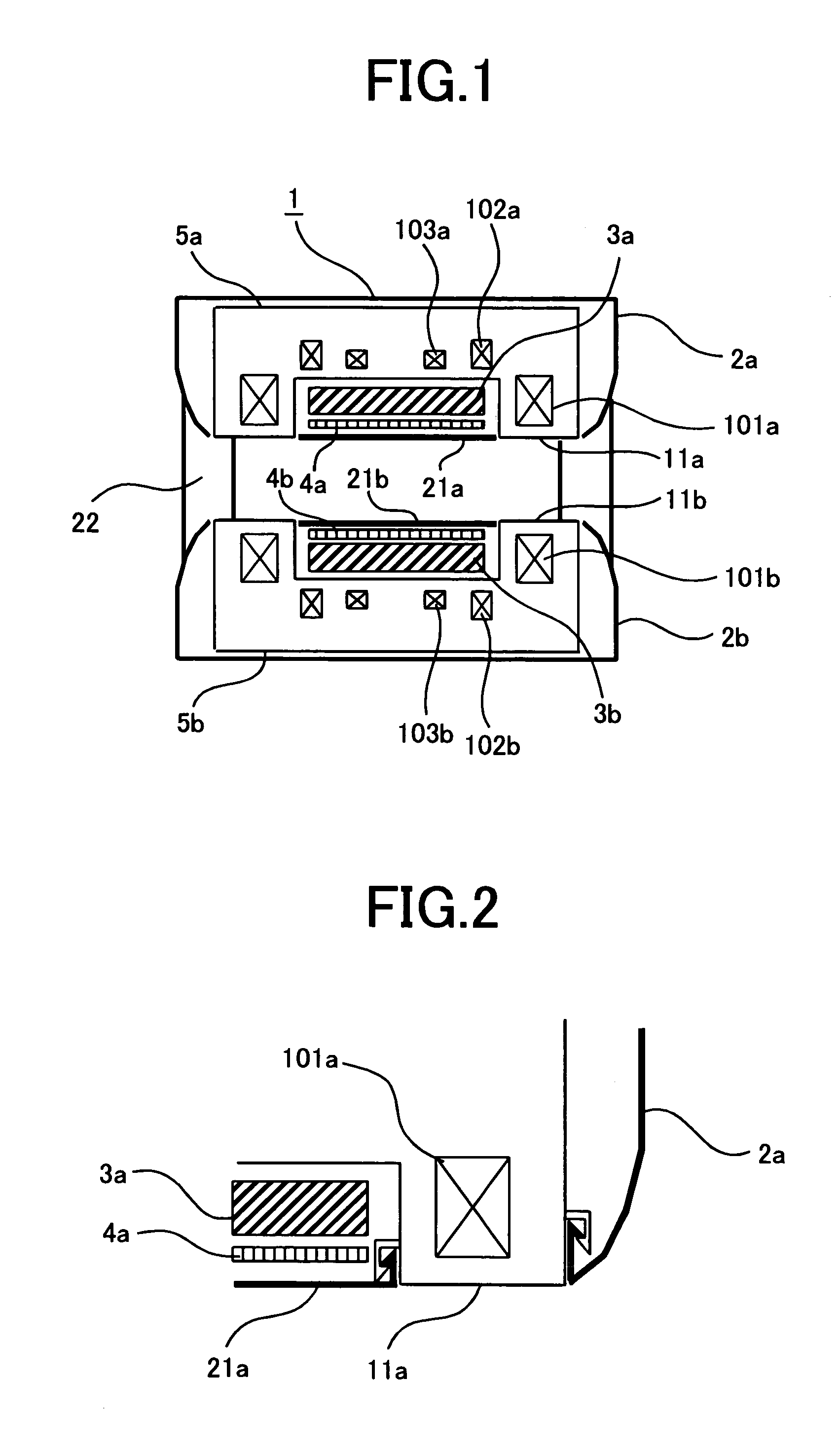Magnetic resonance imaging system
a magnetic resonance imaging and magnetic field technology, applied in the field of magnetic resonance imaging systems, can solve the problems of difficult to meet the contradictory requirements i, and the inability to meet the magnetic so as to enhance the feeling of being not confined and reduce the magnetomotive force of the superconductive coil
- Summary
- Abstract
- Description
- Claims
- Application Information
AI Technical Summary
Benefits of technology
Problems solved by technology
Method used
Image
Examples
embodiment 1
[0020]FIG. 1 is a side view for explaining Embodiment 1 of magnetic resonance imaging systems to which the present invention is applied.
[0021]FIG. 2 is an enlarged view of principal parts in FIG. 1. The magnetic resonance imaging system according to Embodiment 1 is open-type.
[0022]A superconductive electromagnetic device 1 generating a static magnetic field to be applied to a subject is provided with superconductive coils 101a, 102a and 103a illustrated at the top side of FIG. 1, and with superconductive coils 101b, 102b and 103b illustrated at the bottom side of FIG. 1. The superconductive coils 101a through 103a are contained within a vacuum container 5a at the top side via a cooling container filled with liquid helium. Similarly, the superconductive coils 101b through 103b are contained within a vacuum container 5b at the bottom side via a cooling container filled with liquid helium. The vacuum containers 5a and 5b are facing each other, flanking the subject-insertion space with ...
embodiment 2
[0038]FIG. 3 is a side view of a magnetic resonance imaging system, for explaining Embodiment 2. FIG. 4 is an enlarged view of principal parts in FIG. 3. Embodiment 2 is an another aspect of Embodiment 1, wherein circumferential-surface portions of the vacuum containers 5a and 5b are also coated with the thin resin sheets 11a and 11b. In this way, in cases where a magnetic resonance imaging system is produced with the same circumferential dimensions as ever before, the circumferential dimensions of the vacuum containers 5a and 5b can be increased. In consequence, the external diameters of the superconductive coils 101a and 101b can be enlarged.
[0039]In this case, as well, an effect of decreasing the magnetomotive force of the superconductive coils is demonstrated, and a result has been obtained that the magnetomotive force is in reverse proportion to the external diameter, of the superconductive coil, raised approximately to the third power. For example, when the external diameters ...
embodiment 4
[0045]FIG. 6 is a side view of a magnetic resonance imaging system, for explaining Embodiment 4. Embodiment 4 is another aspect of Embodiment 3, wherein the ends of the cylinder or the vacuum containers 5c, in Embodiment 3, are also coated with the thin resin sheets 11c. In this way, in cases where a magnetic resonance imaging system is produced with the same axial length as ever before, the axial length of the vacuum containers 5c can be increased. In consequence, the superconductive coils 101c and 101d can be positioned closer to both ends of the cylinder. Meanwhile, high uniformity in the order of ppm is required of a static magnetic field for a magnetic resonance imaging system, and error components are generally cancelled out each other by combining a plurality of superconductive coils. Therefore, when the winding diameters of the superconductive coils 101c through 103c, and 101d through 103d are unchanged, the larger the axial length of the vacuum container 5c is, the more enh...
PUM
 Login to View More
Login to View More Abstract
Description
Claims
Application Information
 Login to View More
Login to View More - R&D
- Intellectual Property
- Life Sciences
- Materials
- Tech Scout
- Unparalleled Data Quality
- Higher Quality Content
- 60% Fewer Hallucinations
Browse by: Latest US Patents, China's latest patents, Technical Efficacy Thesaurus, Application Domain, Technology Topic, Popular Technical Reports.
© 2025 PatSnap. All rights reserved.Legal|Privacy policy|Modern Slavery Act Transparency Statement|Sitemap|About US| Contact US: help@patsnap.com



